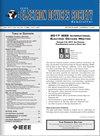Flicker Noise (1/f) in 45-nm PDSOI N-Channel FETs at Cryogenic Temperatures for Quantum Computing Applications
IF 2.4
3区 工程技术
Q3 ENGINEERING, ELECTRICAL & ELECTRONIC
引用次数: 0
Abstract
In this paper, we have investigated the flicker noise (1/用于量子计算应用的 45 纳米 PDSOI N 沟道场效应晶体管在低温条件下的闪烁噪声 (1/f)
本文研究了用于量子计算应用的 45 纳米 RFSOI NFET 中的闪烁噪声(1/ $f$)。我们在低温至 10K 的线性区域对 1/ $f$ 噪声进行了表征和分析。根据偏压条件,还观察到类似洛伦兹的噪声,这可能是由于 PDSOI 的浮动体造成的。提取的频率指数 $(\gamma)$随温度变化呈现倒 U 型,这主要归因于栅极电介质中陷阱的能量分布不均匀。载流子数量波动是 1/ $f$ 噪声的主要来源。对 1/ $f$ 噪声的热激活行为进行了研究,结果表明造成噪声的陷阱不是热激活的。还提取了从 300K 到 10K 的体积陷阱密度。体积陷阱密度随着温度的降低而增加,但在测量的 NFET 中,在低温条件下没有观察到归一化噪声的显著增加。在所研究的温度范围内,陷阱的非均匀分布和热不活泼行为预计是归一化噪声的行为与温度无关的一个合理原因。
本文章由计算机程序翻译,如有差异,请以英文原文为准。
求助全文
约1分钟内获得全文
求助全文
来源期刊

IEEE Journal of the Electron Devices Society
Biochemistry, Genetics and Molecular Biology-Biotechnology
CiteScore
5.20
自引率
4.30%
发文量
124
审稿时长
9 weeks
期刊介绍:
The IEEE Journal of the Electron Devices Society (J-EDS) is an open-access, fully electronic scientific journal publishing papers ranging from fundamental to applied research that are scientifically rigorous and relevant to electron devices. The J-EDS publishes original and significant contributions relating to the theory, modelling, design, performance, and reliability of electron and ion integrated circuit devices and interconnects, involving insulators, metals, organic materials, micro-plasmas, semiconductors, quantum-effect structures, vacuum devices, and emerging materials with applications in bioelectronics, biomedical electronics, computation, communications, displays, microelectromechanics, imaging, micro-actuators, nanodevices, optoelectronics, photovoltaics, power IC''s, and micro-sensors. Tutorial and review papers on these subjects are, also, published. And, occasionally special issues with a collection of papers on particular areas in more depth and breadth are, also, published. J-EDS publishes all papers that are judged to be technically valid and original.
 求助内容:
求助内容: 应助结果提醒方式:
应助结果提醒方式:


